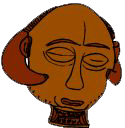|
Table of Contents Art of Mask Making
|
Objectives: 1. Explain how African mask represents and are important symbols of African culture. 2. Understand the tradition and craft of mask making. 3. Create an authentic African mask. Key Words: culture mask ceremonial symbolism rituals tradition Timeline: 3-5 hours Materials: newspaper, wheat paste or Vano liquid starch mixed in equal proportions with water, bowl, spoon, white glue, balloons, scissors, black markers, string and other decorative items and paints. Procedures: 1. Show students samples of African masks either made by past students or purchase from art store. 2. Explain to students the importance of the mask in African culture. Tell them that masks are traditional art forms of Africa. Inform students that each African tribes have their own distinctive style of mask making. They are often worn with a costume that hides the identity of the wearer. They are often used to discipline, educate, inform, or lend authority, this is communicated through movement and dance. They are also used for religious ceremonies to scare away evil spirits. 3. Have student visit the African Art Museum to view the various styles of mask making. Have student select three(3) different tribes listed and write down 3-5 similarities and differences they observed. Discuss with the entire class their observations. 4. Inform students that they will create their own authentic African mask using paper mache. 5. Using a drawing program (Paintbrush, KidPix, etc) have each student design their African mask. Have students print out their design to use as a template. 6. Provide each student a copy of the directions to create their paper mache masks. 7. Using a word processor (Microsoft Word/Works, etc) have students write a paragraph describing the meaning of their mask. 8. Have all students share their masks and paragraph with the class. 9. Exhibit all African masks in a classroom or media center museum. Assessment: Students will be graded on their completed paragraph and mask based on the following rubric: (2) points - mask design (drawing) (4) points - paragraph (topic sentence, supporting details, closing sentence) (4) points- African mask (decorated)
10 points= A; 9-8 points= B; 7 points= C; 6 points= D; 5 points or less= F Extension Activities: Have the students use a digital camera to photograph their completed African masks and then create a virtual gallery on-line. Web Links: African Art Museum: art exploration of the historical art of mask making of selective African tribes throughout history. Bayly Art Museum: art exploration of the cultural and social significance of African masks. PBS: Africa for Kids: learn step-by-step the art of African mask masking. Arts and Craft activity.
|

